Orca review
Posted by Emmanuel
|
Orca review August 18, 2011 03:21PM |
Registered: 13 years ago Posts: 615 |
Since some discussions on the Orca page, and my workshop in Barcelona (we built three printers, and I justly chose the Orca to test it) I wanted to write a little review, so there it is :
In short :
I think my classic Mendel is good and I'm proud of it (heh I made my glasses with it), but the Orca feels better (or maybe it was the 1,75mm filament ?)
I would typically recommend this type of machine if you are in Europe and looking for a kit (since we don't have full prusa kit sellers like Makergear here), but also be patient, only mendel-parts sells them at this moment (but everyone can, and you can also self-source it, like Tarjak told us on the IRC, he only bought the motors/electronics).
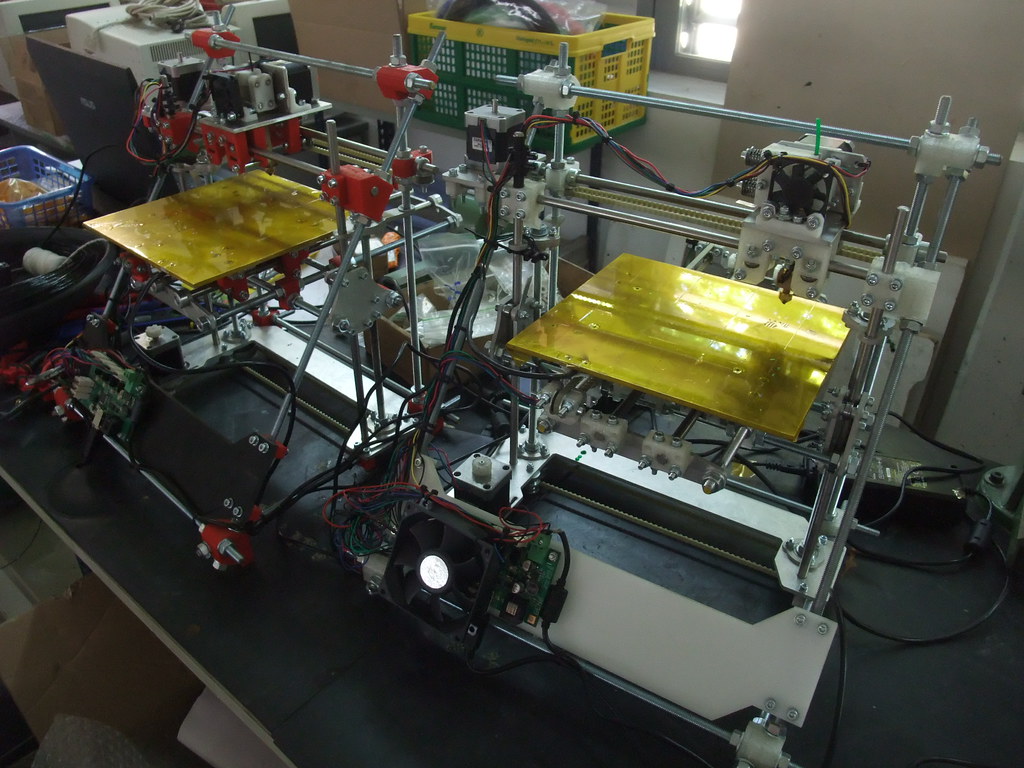
By the way, Camiel designed it without really knowing about the Prusa Mendel (he saw it physically for the first time when coming in Spain, a local student was making one), as he said his intention was to replace the Sells Mendel with a more production-friendly machine, but also easy to assemble (almost as easy as a Prusa I would say, Clax on the mendel-parts forum even said to have assembled it in only 10hrs).
So if you want to compare, think first about the classic Mendel (personnaly I think I will place it between the Sells and the Prusa, but very close to the Prusa, so it's a good improvement from the classic mendel).
By its design it's a whole new fork in the RepRap Family (we don't see often a different distribution of the XYZ movements) and the Orca have some very interesting ideas :
* I think the futur is in the bowden or in the direct drive extruders, the v9 is of the latest type (finally why using gears ?^^), and it was so accessible than back to my Mendel my greg-wade seems bulky and non-practical (that's also why I starded to design an x-carriage-struder).

* On the v9 hot-end, it have no PTFE, its only PEEK, I would like to show you a technical drawing but the principle is : two separate brass (as a thermal break) screwed in PEEK, on the lower brass there is the nozzle and heater block ; and (the interesting part) the upper brass, which is cold at touch, serve to mount the hotend on the x-carriage with just a nut (no mounting block).

Making a modular hotend which (I'm just seeing) seems to be sold at around 30-40€ (if you take only the 6 parts of the hotend). But it need to be well assembled to avoid any leakage (or maybe return to the v2 with a brass which don't need a nozzle).
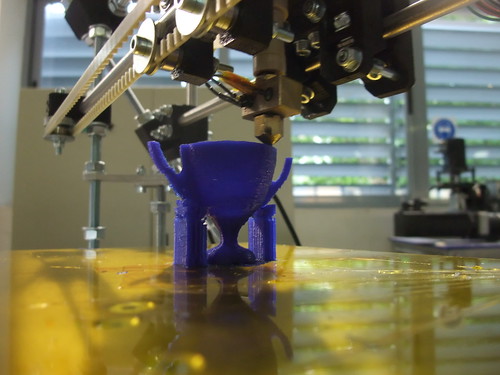
* The short belts : I prefer the mechanical simplicity of a belt-driven Z-axis, rather than the as simple but somewhat brutal "two-motor in parallel" approach in the Prusa (and between the two I like even more what made Vato, see this other thread, there is a link to a video and a picture down in the thread)
* And some other benefits, among: few different longer of rods, you can put your hand under the bed to pull on the z-belt when needing to make manual long move, with all the rods the frame is very stiff (- caution, the build is less forgiveable of misalignement and unsquareness, we had to rebuild one of the three orca from the beginning because two students went to fast)
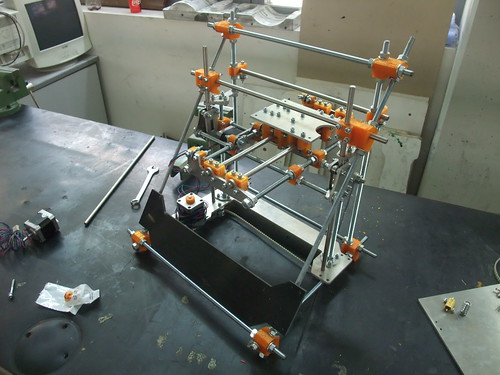
On the "thick-sheet waterjet-cutted parts" controversy :
*For those that were horrified by that, I understand because it's awesome once you have a printer to be able to print other parts for other printers, but I already thought it's more efficient/resilient to rely on an ecology of fabrication containing other machine than 3d printers.
Self-replicating printers are cool, but if you don't have access to a 3dprinter it's the same, you will have to order your parts to someone, and for the other who are lucky to have access to a laser/water-cutter it's an interesting option.
*Don't forget that's also possible to cut the thick sheet by hands, in metal or wood, exactly like for the "frog" in the Sells Mendel (the thick sheet are even less complex).
*My real point in this controversy : I think we can make all the watercutted part printable in few hours (extrude-profile/print, only the big bottom part will need to be printed in two part) and we can simplify the whole.
**Behind that, it's the nice idea of parts that makes you take automatically the right dimensions during the build
For the YZ bed (maybe the most visible difference), I see some pro/cons :
+ The extruder being a critical part it may be good to only move it in X
+ When you push on the filament it dont stress the Z-axis (when changing or if it skip)
+ Many professional machines have a Z-bed configuration (maybe a reason ?)
- It's a big part to move and the movement in Y don't help
- Obviously it's more wheight lifting the whole bed in Z rathen than the extruder-axis
(+ But not a great deal, I mean it works, and during a print its on the good side of gravity, it only have to lower... maybe that's the reason why professional machine almost all works in that configuration ?)
- The bed goes out of the "back" of the frame (but the instability is only visual)
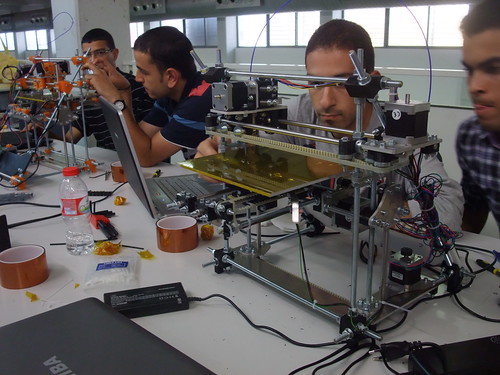
I'm really wondering if there is a preferable strategy for the XYZ distribution...XZ or YZ ? At least making the X or Y axis moving in Z is good for the volume, that permit other shapes than a cube (thinking of makerbot, ultimaker, shapercube... except the "specials" delta, rotating and arm based concept).
[edit] a very ++ point after a short discussion with Tarjak, for a granule extruder (that he may test in near futur) it's better to have the extruder always on the top of the machine
On the improvements we can make : (remember, it's open-hardware, if you are not happy change it)
* design printable parts of the actual watercutted parts
* redesign some printed parts to ease the build (i.e. in the Y-axis two parts could be one, and thus we don't have to check the distance between them, other can be fused together)
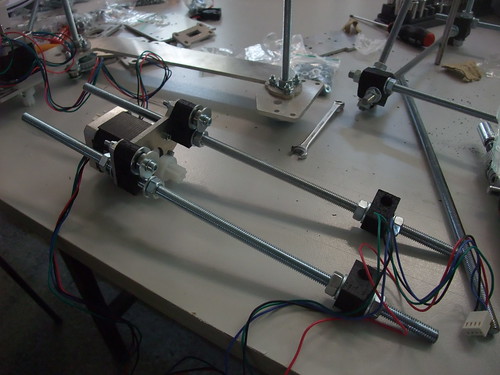
* make a version with bushing or linear bearing (that will greatly simplify the design).
Now who's gonna make the Prusa of the Orca ? Taking the best of every machines and starting a new fork ^^ (I'm sure it's possible... I'll try when rebuilding them :p)
More people are building Orca now, I hope we can collect their review in the near futur.
Edited 7 time(s). Last edit at 08/22/2011 06:18PM by Emmanuel.
about // liberapay // flickr // wiki // thingiverse - github
In short :
I think my classic Mendel is good and I'm proud of it (heh I made my glasses with it), but the Orca feels better (or maybe it was the 1,75mm filament ?)
I would typically recommend this type of machine if you are in Europe and looking for a kit (since we don't have full prusa kit sellers like Makergear here), but also be patient, only mendel-parts sells them at this moment (but everyone can, and you can also self-source it, like Tarjak told us on the IRC, he only bought the motors/electronics).

By the way, Camiel designed it without really knowing about the Prusa Mendel (he saw it physically for the first time when coming in Spain, a local student was making one), as he said his intention was to replace the Sells Mendel with a more production-friendly machine, but also easy to assemble (almost as easy as a Prusa I would say, Clax on the mendel-parts forum even said to have assembled it in only 10hrs).
So if you want to compare, think first about the classic Mendel (personnaly I think I will place it between the Sells and the Prusa, but very close to the Prusa, so it's a good improvement from the classic mendel).
By its design it's a whole new fork in the RepRap Family (we don't see often a different distribution of the XYZ movements) and the Orca have some very interesting ideas :
* I think the futur is in the bowden or in the direct drive extruders, the v9 is of the latest type (finally why using gears ?^^), and it was so accessible than back to my Mendel my greg-wade seems bulky and non-practical (that's also why I starded to design an x-carriage-struder).

* On the v9 hot-end, it have no PTFE, its only PEEK, I would like to show you a technical drawing but the principle is : two separate brass (as a thermal break) screwed in PEEK, on the lower brass there is the nozzle and heater block ; and (the interesting part) the upper brass, which is cold at touch, serve to mount the hotend on the x-carriage with just a nut (no mounting block).

Making a modular hotend which (I'm just seeing) seems to be sold at around 30-40€ (if you take only the 6 parts of the hotend). But it need to be well assembled to avoid any leakage (or maybe return to the v2 with a brass which don't need a nozzle).

* The short belts : I prefer the mechanical simplicity of a belt-driven Z-axis, rather than the as simple but somewhat brutal "two-motor in parallel" approach in the Prusa (and between the two I like even more what made Vato, see this other thread, there is a link to a video and a picture down in the thread)
* And some other benefits, among: few different longer of rods, you can put your hand under the bed to pull on the z-belt when needing to make manual long move, with all the rods the frame is very stiff (- caution, the build is less forgiveable of misalignement and unsquareness, we had to rebuild one of the three orca from the beginning because two students went to fast)

On the "thick-sheet waterjet-cutted parts" controversy :
*For those that were horrified by that, I understand because it's awesome once you have a printer to be able to print other parts for other printers, but I already thought it's more efficient/resilient to rely on an ecology of fabrication containing other machine than 3d printers.
Self-replicating printers are cool, but if you don't have access to a 3dprinter it's the same, you will have to order your parts to someone, and for the other who are lucky to have access to a laser/water-cutter it's an interesting option.
*Don't forget that's also possible to cut the thick sheet by hands, in metal or wood, exactly like for the "frog" in the Sells Mendel (the thick sheet are even less complex).
*My real point in this controversy : I think we can make all the watercutted part printable in few hours (extrude-profile/print, only the big bottom part will need to be printed in two part) and we can simplify the whole.
**Behind that, it's the nice idea of parts that makes you take automatically the right dimensions during the build
For the YZ bed (maybe the most visible difference), I see some pro/cons :
+ The extruder being a critical part it may be good to only move it in X
+ When you push on the filament it dont stress the Z-axis (when changing or if it skip)
+ Many professional machines have a Z-bed configuration (maybe a reason ?)
- It's a big part to move and the movement in Y don't help
- Obviously it's more wheight lifting the whole bed in Z rathen than the extruder-axis
(+ But not a great deal, I mean it works, and during a print its on the good side of gravity, it only have to lower... maybe that's the reason why professional machine almost all works in that configuration ?)
- The bed goes out of the "back" of the frame (but the instability is only visual)

I'm really wondering if there is a preferable strategy for the XYZ distribution...XZ or YZ ? At least making the X or Y axis moving in Z is good for the volume, that permit other shapes than a cube (thinking of makerbot, ultimaker, shapercube... except the "specials" delta, rotating and arm based concept).
[edit] a very ++ point after a short discussion with Tarjak, for a granule extruder (that he may test in near futur) it's better to have the extruder always on the top of the machine

On the improvements we can make : (remember, it's open-hardware, if you are not happy change it)
* design printable parts of the actual watercutted parts
* redesign some printed parts to ease the build (i.e. in the Y-axis two parts could be one, and thus we don't have to check the distance between them, other can be fused together)

* make a version with bushing or linear bearing (that will greatly simplify the design).
Now who's gonna make the Prusa of the Orca ? Taking the best of every machines and starting a new fork ^^ (I'm sure it's possible... I'll try when rebuilding them :p)
More people are building Orca now, I hope we can collect their review in the near futur.
Edited 7 time(s). Last edit at 08/22/2011 06:18PM by Emmanuel.
about // liberapay // flickr // wiki // thingiverse - github
|
Re: Orca review August 18, 2011 07:58PM |
Registered: 12 years ago Posts: 1,611 |
|
Re: Orca review August 19, 2011 02:35AM |
Registered: 13 years ago Posts: 7,616 |
Thanks for the great review, Emmanuel.
How is it about rigidity? Is this Orca thing stiffer or even weaker than a Prusa/Sells Mendel? I'm asking, because I'm always after an machine capable of hooking up a Dremel-like tool, for replicating PCBs.
How is it about rigidity? Is this Orca thing stiffer or even weaker than a Prusa/Sells Mendel? I'm asking, because I'm always after an machine capable of hooking up a Dremel-like tool, for replicating PCBs.
| Generation 7 Electronics | Teacup Firmware | RepRap DIY |
|
Re: Orca review August 19, 2011 04:56AM |
Admin Registered: 16 years ago Posts: 13,886 |
Hi Marcus,
you can achieve much higher stiffness with pairs of diagonal (or best fit for the triangles) steel-wires in the structural frames.
Viktor
--------
Aufruf zum Projekt "Müll-freie Meere" - [reprap.org] -- Deutsche Facebook-Gruppe - [www.facebook.com]
Call for the project "garbage-free seas" - [reprap.org]
you can achieve much higher stiffness with pairs of diagonal (or best fit for the triangles) steel-wires in the structural frames.
Viktor
--------
Aufruf zum Projekt "Müll-freie Meere" - [reprap.org] -- Deutsche Facebook-Gruppe - [www.facebook.com]
Call for the project "garbage-free seas" - [reprap.org]
|
Re: Orca review August 19, 2011 05:54AM |
Registered: 13 years ago Posts: 615 |
Quote
Traumflug
Thanks for the great review, Emmanuel.
How is it about rigidity? Is this Orca thing stiffer or even weaker than a Prusa/Sells Mendel? I'm asking, because I'm always after an machine capable of hooking up a Dremel-like tool, for replicating PCBs.
I hooked up a flexible-shaft-dremel on my Mendel once
 (just for a quick test at milling plexiglass [flic.kr] but with some patience and a vacuum cleaner maybe pcb are doable ?)
(just for a quick test at milling plexiglass [flic.kr] but with some patience and a vacuum cleaner maybe pcb are doable ?)In order of stiffness I would say : prusa mendel < sells mendel (thanks to the electronic board) < orca
Or as said Vik, we can add diagonals (since the pcb is close to the height of the bed it will not be a problem to "close" the sides)
|
Re: Orca review August 19, 2011 07:07AM |
Registered: 13 years ago Posts: 228 |
PCBs require less forces than plexiglass.
The Prusa Mendel shows slight but noticeable vibration even with the motors isolated from the frame by cork.
In my view: the diagonals may help, but we'll still have significant vibration problems while milling with those 8mm threaded bar designs. Not optimized for that.
Thinking about composites, combinations of dampening and stiff materials. Metal bars + plywood + epoxy-granite? A way to explore?
The Prusa Mendel shows slight but noticeable vibration even with the motors isolated from the frame by cork.
In my view: the diagonals may help, but we'll still have significant vibration problems while milling with those 8mm threaded bar designs. Not optimized for that.
Thinking about composites, combinations of dampening and stiff materials. Metal bars + plywood + epoxy-granite? A way to explore?
|
Re: Orca review August 23, 2011 12:32PM |
Registered: 12 years ago Posts: 313 |
Traumflug Wrote:
-------------------------------------------------------
> How is it about rigidity? Is this Orca thing
> stiffer or even weaker than a Prusa/Sells Mendel?
> I'm asking, because I'm always after an machine
> capable of hooking up a Dremel-like tool, for
> replicating PCBs.
A fresh Orca user reporting here. I have no experience with other RepRaps, but the rigidity of the frame looks very good, even under hard X moves, and the standard toolhead is already probably more than half a kilogram. Rigidity-wise the weakest link is from the build plate to the Z carriage - when the build plate accelerates hard, it really doesn't look as stable as it could be. It's got a lot of leverage against the support bars and Z carriage...
Also, I really would like to meet the person who dares to call the roller bearing carriages easy to build and adjust. Those are a total pain in the backside. Come on, what's wrong with linear bearings? Using those would probably cut the building time by half if not two thirds...
-------------------------------------------------------
> How is it about rigidity? Is this Orca thing
> stiffer or even weaker than a Prusa/Sells Mendel?
> I'm asking, because I'm always after an machine
> capable of hooking up a Dremel-like tool, for
> replicating PCBs.
A fresh Orca user reporting here. I have no experience with other RepRaps, but the rigidity of the frame looks very good, even under hard X moves, and the standard toolhead is already probably more than half a kilogram. Rigidity-wise the weakest link is from the build plate to the Z carriage - when the build plate accelerates hard, it really doesn't look as stable as it could be. It's got a lot of leverage against the support bars and Z carriage...
Also, I really would like to meet the person who dares to call the roller bearing carriages easy to build and adjust. Those are a total pain in the backside. Come on, what's wrong with linear bearings? Using those would probably cut the building time by half if not two thirds...
|
Re: Orca review September 29, 2011 11:53PM |
Registered: 12 years ago Posts: 12 |
Lanthan Wrote:
-------------------------------------------------------
> In my view: the diagonals may help, but we'll
> still have significant vibration problems while
> milling with those 8mm threaded bar designs. Not
> optimized for that.
>
> Thinking about composites, combinations of
> dampening and stiff materials. Metal bars +
> plywood + epoxy-granite? A way to explore?
How about just mounting the frame on a 1 cm board and parking an entirely separate chassis on the board beside it to hold the motors and transfer power with belt drives? For that matter, separate X from the YZ stage. Of course, if you take this kind of thinking far enough, you wind up going all wood construction and end up with Ultimaker.
-------------------------------------------------------
> In my view: the diagonals may help, but we'll
> still have significant vibration problems while
> milling with those 8mm threaded bar designs. Not
> optimized for that.
>
> Thinking about composites, combinations of
> dampening and stiff materials. Metal bars +
> plywood + epoxy-granite? A way to explore?
How about just mounting the frame on a 1 cm board and parking an entirely separate chassis on the board beside it to hold the motors and transfer power with belt drives? For that matter, separate X from the YZ stage. Of course, if you take this kind of thinking far enough, you wind up going all wood construction and end up with Ultimaker.
Sorry, only registered users may post in this forum.